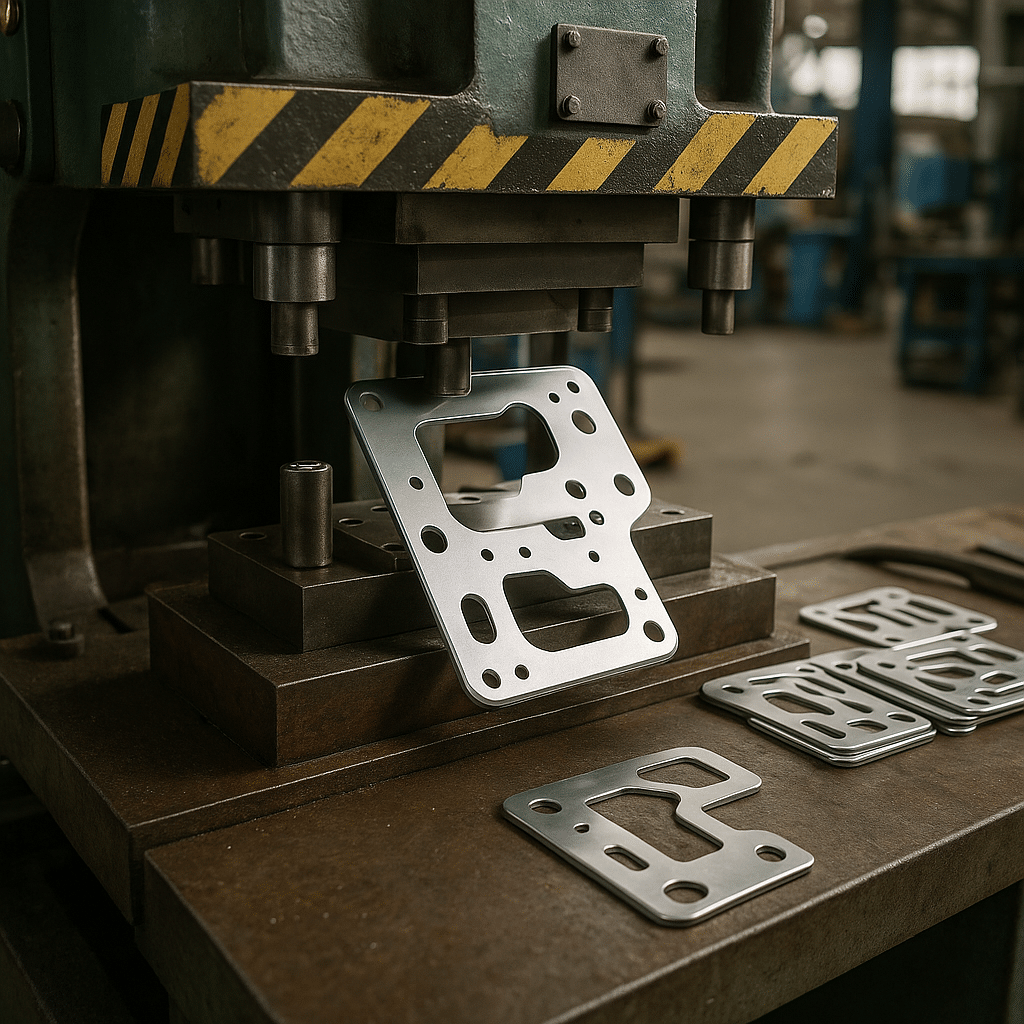1. What Is Stamping/Pressing?
1.1 Process Features:
● Stamping:
– Use the punch and die to shear, bend, and draw to change metal’s shape and size
– It is typically used to produce metal stamping parts of various shapes, such as automotive interior parts, electronic product housings, etc
– Apply pressure to shape metals
– In addition to producing stamping parts, it also includes the pressing of some metal powders and the pressing of metal sheets
1.2 Tools Used:
● Stamping typically relies on precision dies (e.g., progressive dies) and rapid reciprocating motion (high-speed punch presses), and is suitable for mass production of small parts (e.g., electronic contacts, gaskets)
● Pressing may use simpler dies to form complex shapes (e.g., aluminum cookware, automotive structural parts) through slow, continuous pressure
1.3 Material and Thickness
● Stamping is mostly used for thin sheet metal (0.1~6mm), such as steel, aluminum, and copper
● Pressing can handle thicker materials or block metals (such as forged aluminum alloy wheels)
1.4 Terminology Differences
● Although metal stamping and metal pressing have subtle distinctions, they are often used interchangeably
2. Metal Stamping Materials
2.1 Material Properties
● Good formability
● Good strength
● Moderate hardness
● Low yield strength
● Thickness range
– Regular stamping: 0.1~6mm thin plate/strip
– Thick plate stamping (>6mm): requires a large-tonnage hydraulic press or hot stamping
2.2 Common Metal Stamping Materials
| Table 1 – Common Metal Stamping Materials | ||||
| Materials | Grade | Features | Applications | Notes |
| Low Carbon Steel | ● Chinese grades: Q195, Q235 ● American grades: AISI 1008~1018 ● Japanese grades: SPCC, SPHC | ● Low carbon content ● Good plasticity, formability ● Low cost | ● Widely used in automobiles, home appliances, structural parts (such as brackets, housings) | ● Require surface finishes for corrosion resistance ● Surface finish: Electroplating, painting |
| Stainless Steel | ● Austenitic stainless steel: such as 304, 316 ● Ferritic stainless steel: such as 430 | ● Strong corrosion resistance, but work hardening ● Magnetic, good formability, low cost | ● Kitchenware and medical equipment ● Electrical components | ● Require high-tonnage punch or intermediate annealing |
| Aluminum Alloy | ● 1xxx series, pure aluminum: such as 1050, 1100 ● 3xxx series: such as 3003 ● 5xxx series: such as 5052 | ● High plasticity ● Contains manganese, slightly higher strength ● Corrosion resistant | ● Deep drawing: such as cans ● Sheet metal parts ● Ships and automobiles | ● Lightweight, corrosion resistant, but low elastic modulus, need to control rebound |
| Copper & Brass | ● Pure copper: such as T2) ● Brass: H62, H65 | ● Good conductivity ● Zinc content 30%~40%, balanced strength and formability | ● Electronic terminals and heat sinks ● Hardware: such as locks, shells | ● Bronze: Less used for stamping, more used for casting |
| Coated Steel | ● Galvanized Steel: Galvanized Iron, Electro Galvanized ● Tinplate (tinplate) ● Color-coated Steel (PPGI/PPGL) | ● Anti-rust ● Surface covered with organic coating, directly stamped and formed | ● Automobile bodies and chassis ● Food packaging: such as cans ● Architectural decoration | ● The die needs to be polished to avoid coating peeling |
2.3 Why Are Plastics Not Suitable for Stamping?
● Material Properties
– Weak Formability: Most plastics have high elasticity and low ductility, and are prone to cracking or rebounding during stamping (such as PC and PMMA)
– Thermal Sensitivity: Softening at high temperatures (such as PVC deforming at 80°C), and stress whitening or cracking are easily produced when stamping at room temperature
– Insufficient Hardness: There may be plastic sticking on the die or burrs during shearing
● Process
– Metal stamping relies on the plastic flow of the material, while plastics rely more on melt flow or elastic deformation
2.4 Alternatives to Plastic Stamping
2.4.1 Die Cutting
– Materials: Thin plastics (PET film, PVC cardboard, foam)
– Features: Use die pressure to cut, no heating required
– Applications: Non-structural parts such as labels and packaging boxes
2.4.2 Thermoforming
– Materials: Thermoplastics (ABS, PS, PETG)
– Features: After heating and softening the plastic sheet, use a mold to press it into shape
– Applications: Fast food boxes, refrigerator liners)
2.4.3 Cold Stamping (Special Plastics Only)
– Materials:
** Filled modified plastics: glass fiber reinforced PA66, mineral filled PP etc, with hardness close to metal
** Engineering plastics: POM, PEEK, etc, with high rigidity and low rebound
– Features:
** Reduce the stamping speed and use sharp dies
** Precisely control temperature and stamping pressure
2.4.4 Hydroforming
– Materials: Thermoplastic sheets, such as PC, PMMA
– Features: Apply uniform pressure through hydraulic pressure to avoid local stress cracking
3. Metal Stamping Applications
Metal stamping is widely used in almost all industries that require sheet metal components.
| Table 2 – Metal Stamping Applications | ||
| Fields | Features | Applications |
| Automobile | ● High-strength steel, aluminum alloy stamping, ● Require high precision and light weight | ● Structural parts: doors, hoods, roofs, chassis parts (longitudinal beams, cross beams) ● Safety parts: airbag housings, seat belt buckles, anti-collision beams ● Functional parts: fuel tanks, exhaust pipes, heat sinks, battery housings (new energy vehicles) ● Interior parts: instrument panel brackets, seat slides, air conditioning outlets |
| Electronic and Electrical | ● Small precision parts ● Mostly made of copper, stainless steel or coated steel plates | ● Connectors: USB ports of mobile phones/computers, SIM card trays, radio frequency shielding covers ● Heat dissipation components: CPU heat sinks, heat pipe fins ● Home appliance parts: inner drums of washing machines, microwave oven panels, and refrigerator hinges ● Battery components: lithium battery pole pieces, nickel-hydrogen battery shells |
| Aerospace and Military | ● High-strength materials (titanium alloy, nickel-based alloy) ● Complex curved surface parts | ● Aircraft structural parts: wing ribs, door frames, engine blades (hot stamping required) ● Spacecraft parts: satellite brackets, rocket fuel tank thin-walled parts ● Military parts: shells, fuze mechanisms, armor plates |
| Architecture and Home | ● Large sheet metal parts ● Focus on rust prevention and beauty | ● Building materials: metal roofs, curtain wall keels, ventilation ducts ● Hardware: door locks, hinges, rails, bathroom brackets ● Decorative parts: ceiling patterned plates, metal skirtings |
| Medical Equipment | ● High cleanliness, corrosion-resistant materials (such as 316L stainless steel) | ● Surgical instruments: tweezers, scissor handles, orthopedic fixation plates ● Equipment parts: MRI machine housing, bed bracket, medical tray ● Implants: dental implants (precision stamping + polishing required) |
| Energy and Electricity | ● High temperature resistance, high requirements for electrical/thermal conductivity | ● Electric equipment: transformer copper sheet, circuit breaker contacts, meter housing ● New energy components: solar brackets, wind power gearbox housing ● Petrochemical: pipeline flanges, valve components |
| Daily Necessities and Packaging | ● Low cost, mass production | ● Containers: cans, metal food boxes, aerosol cans ● Hardware tools: wrenches, pliers heads, blades ● Stationery: staples, paper clips, file holders |
| Others | / | ● Railway transportation: high-speed rail seat frames, subway doors ● Shipbuilding: marine ventilation grids, waterproof hatch covers ● Toy industry: metal assembly models, clockwork components |
4. Manufacturing Tools and Dies for Metal Pressing/Stamping
4.1 Metal Stamping Tooling
Tooling refers to all tools and equipment to facilitate stamping production, including:
4.1.1 Stamping Mold (Also Known as Die)
A specialized tool used in metal stamping or pressing to shape flat sheet metal into desired forms
4.1.2 Positioning and Clamping Tooling
Positioning Fixture: Ensure the precise position of the sheet in the mold (such as robot suction cup, lateral positioning block)
Clamping Tooling: Hydraulic/pneumatic clamp to prevent material displacement during stamping
4.1.3 Auxiliary Tooling
Feeding Mechanism: Roller feeder, progressive die automatic feeding device
Discharging Device: Waste cutter, finished product blowing separation system
Detection Tooling: Online dimension measuring instrument, visual positioning system
4.1.4 Commissioning and Maintenance Tools
Testing Mold Tooling: Pressure test block that simulates the stamping process
Mold Maintenance Tools: Polishing machine, in-mold laser cleaning equipment
4.2 Metal Stamping Molds/Dies
4.2.1 Categorized By Processes
| Table 3 – Metal Stamping Molds/Dies – Categorized By Processes | ||
| Mold Types | Purpose | Applications |
| Punching Die | ● Shearing materials ● Blanking, punching, cutting, notching, trimming, sectioning | ● Gasket punching die ● Circuit board blanking die |
| Bending Die | ● Bend the sheet into an angle and shape | ● Door hinge bending die ● U-shaped bracket forming die |
| Drawing Die | ● Draw the flat plate into a hollow part | ● Stainless steel cup deep drawing die ● Automobile fuel tank die |
| Forming Die | ● Shape the blank or semi-finished workpiece according to the shape of the convex and concave dies ● Bulging, shrinking, expanding, undulating forming, flanging, shaping | ● Automobile logo embossing die ● Radiator fin die |
4.2.2 Categorized By Structures
| Table 4 – Metal Stamping Molds/Dies – Categorized By Structures | ||
| Mold Types | Purpose | Applications |
| Single Process Die | ● Complete one stamping process in one time | ● Simple parts with low volume orders |
| Compound Stamping Die | ● Single station completes multiple processes (punching + bending etc) | ● Electrical contact integrated molding mold |
| Progressive Mold/ Continuous Die | ● Multi-station continuous processing (feeding step by step) | ● Mobile phone shield progressive mold ● Lead frame mold |
| Transfer Mold | ● Robot transfers semi-finished products between workstations | ● Large parts: such as car door panels |
4.2.3 Special Process Molds
I. Hydroforming
● Utilize liquid pressure instead of convex and concave dies to shape sheet metal
● Can process parts with complex shapes
● Applications: Magnesium, aluminum, titanium alloy and complex structure welded plates
II. Hot Stamping/Press Hardening
● Heat the blank to a certain temperature, then stamp and quench in the mold to obtain the desired shape
● Applications: Automobile A/B pillar, front and rear bumpers etc
III. Micro Stamping
● Create extremely tiny parts with size of less than 0.1mm
● Applications: medical catheter connector
4.2.4 Fundamental Structure of a Stamping Mold
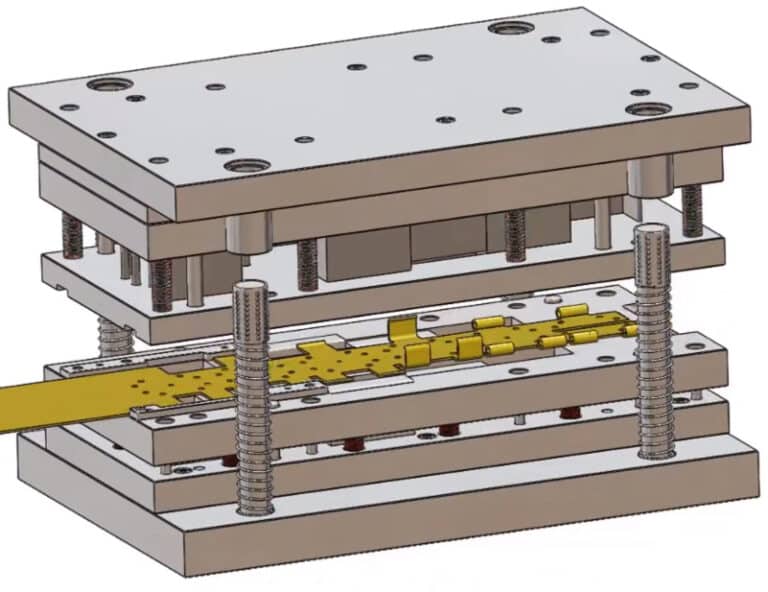
● Mold Frame: Includes upper and lower mold bases, the main function is to support and install other parts
● Guide Device: Consists of guide pins and guide sleeves to ensure accurate alignment of upper and lower mold bases
● Working Parts: Includes convex and concave dies to shape materials
● Releasing Device: Such as unloading plates and ejectors, releasing workpieces or waste from the mold
● Positioning Parts: Such as positioning pins and stoppers, to ensure the correct position of the blank during stamping
● Fasteners: Such as screws and pins, used to connect and fix various parts of the mold
● Fixed Plate: Used to fix various parts of the mold and ensure the positioning of parts
● Pads: Used to disperse impact loads
5. Types of Metal Stamping Techniques
5.1 Single Process Die Stamping
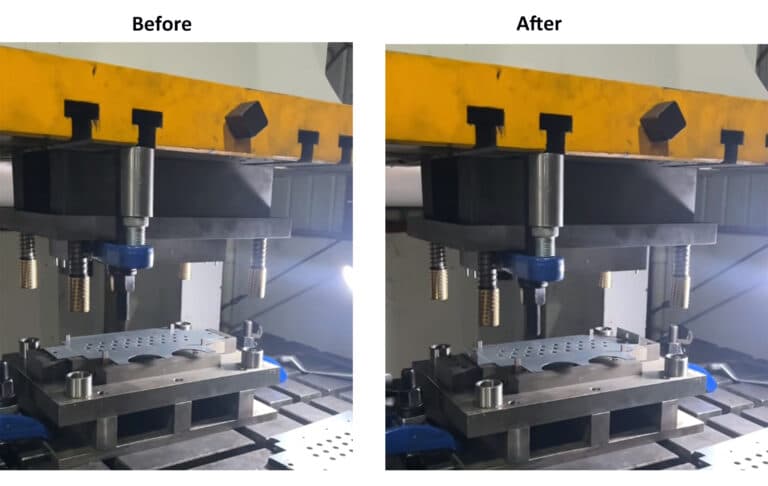
● Features:
– Complete one stamping process at a time
– Take out the part from the die manually or by a robot, and then place it in the die of the next station for continued production
● Advantages:
– Simple Structure: The single process die completes only one stamping, and its structure is simple. There are no complex multi-station or compound structures, with low manufacturing difficulty and short manufacturing lead time
– Low Cost: Due to the simple structure, it only requires small amount of materials, working hours and processes, so the mold manufacturing cost is low. And the maintenance cost is also low due to easy maintenance
– Strong Versatility: Not limited by the parts’ size, it is suitable for making small and medium-sized stamping parts, as well as some parts with larger dimensions and thicker thickness. The convex and concave dies can be quickly replaced to produce different shapes and sizes of stamping parts
– Easy to Adjust: It is convenient to install and adjust the gap between the convex and concave dies, to ensure the quality of stamping
– Recycling Waste: In some cases, waste can be used for stamping to improve material utilization and reduce production costs
● Disadvantages:
– Low Part Precision: It only completes one process in one stamping stroke, and it’s unable to improve the part precision by coordinating multiple processes. Moreover, due to the simple mold structure and the large positioning error, the size, shape and position accuracy of the parts are poor
– Low Production Efficiency: Each stamping stroke can only complete one process, and multiple stampings are required to complete the entire processing, causing low production efficiency, not suitable for high volume orders
– Work Processes Not Taken Together: The stamping parts need to be processed on different molds, which increases the logistics movement in the plant, and also increases the production management difficulty
– Inconvenient Installation and Adjustment: single-process molds are mostly without guide devices, and it takes more time and effort to install and adjust
– Low Mold Lifetime: Due to the simple structure and low mold strength and durability, it is easy to have problems such as wear and deformation, resulting in a short mold life, and the mold needs to be replaced frequently, which increases production costs
5.2 Compound Die Stamping
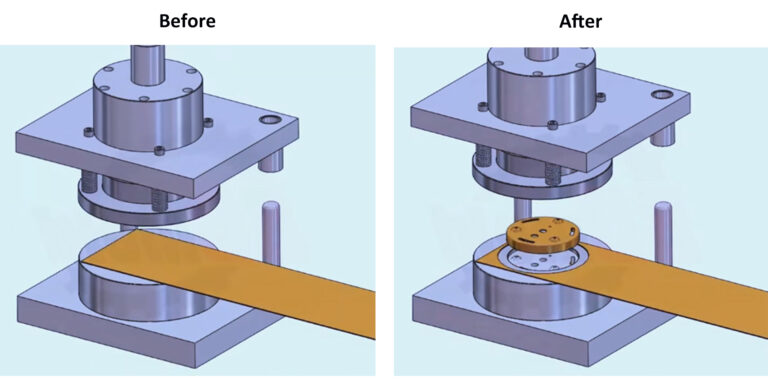
● Features:
– Single station completes multiple processes (punching + bending etc)
– They may be a set of combinations of different processes, such as punching, blanking, drawing or shaping
● Advantages:
– High Production Efficiency: A set of molds can complete multiple stamping processes. Compared with single-process molds, it can significantly improve production efficiency, shorten the production cycle time, and reduce the number of equipment and operators, which lowers labor and management costs
– High Quality: Different stamping processes are completed at the same station, without repeated positioning, the coaxiality accuracy of the inner and outer shapes of the parts is high. The parts are straight and the surface quality is good
– Lax Material Requirements: Since there is no secondary feeding, it is generally not limited by the shape and size of the strip material. Short materials and corners can be fully utilized, and it is suitable for punching thin materials, soft materials and brittle materials
– Compact Die Structure: Compared with progressive mold, the compound stamping die has smaller outer dimensions, occupies less area
● Disadvantages:
– Complex Mold Structure: The mold structure is more complex than that of a single-process die, and the mold has more movements. It requires that the various parts of the mold do not interfere with each other, be stable and reliable, and be coordinated during the movement, which causes long manufacturing lead time and increases the manufacturing cost
– Limited Wall Thickness of Convex and Concave Dies: The dimensions cannot be too small, otherwise the mold strength will be affected and it cannot be used normally. The wall thickness between the inner and outer shapes of the convex and concave dies cannot be too thin, otherwise its strength is insufficient and it will cause expansion and damage
– Limited Applications: Generally suitable for punching production with high volume and precision, complex soft and thin materials with a thickness of no more than 3mm
5.3 Progressive Mold/Continuous Die Stamping
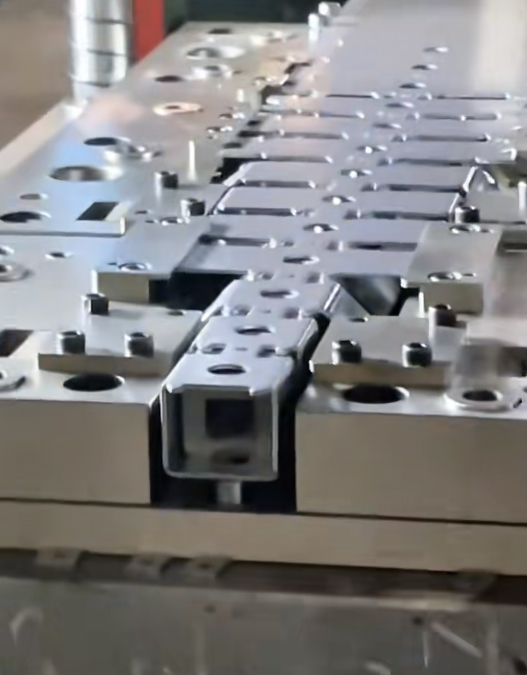
● Features:
– Arrange the whole stamping process (stations) in the same set of molds for stamping
– The feeder sends coil materials to each separate station in the mold at equal distances, and the product is completed at the last station
– The material will be processed in the continuous die in several steps: punching, separation, bending, etc
● Advantages:
– High Production Efficiency: Two or more stamping processes can be completed at different stations in one stroke. It has higher production efficiency than the compound stamping die and can produce a large number of stamping parts quickly and continuously
– Safe Operation: Can effectively avoid the safety risks caused by manual operation. At the same time, it is easy to realize automatic operation and reduce labor costs
– Good Mold Strength and Long Lifetime: the processes do not have to be in the same station, there is no issue of “minimum wall thickness” , the mold strength is relatively good, and the service life is long
– High Precision of Parts: Since there is no manual feeding and the positioning accuracy of each station is high, the precision of the parts is higher than that of the single process die, which can ensure the dimensional accuracy and shape accuracy of the stamped parts
– Easy to Realize Automation: From loading, feeding, processing, and unloading, all can be automated. It can be combined with feeders, punching machines and other equipment to form an automated production line to improve production efficiency and product quality stability
– Save Space: It can complete the production of a product with a machine, which occupies a small area, and also simplifies the movement of raw materials, components and semi-finished products.
● Disadvantages:
– Complex Structure: It is usually composed of multiple stations, the structure and function of each station are relatively independent, and precise positioning and feeding devices are required, resulting in a relatively complex overall structure of the mold
– High Manufacturing Precision Requirements: In order to ensure the processing and feeding precision of each station, the mold manufacturing precision and equipment are required to be high, which increases the manufacturing difficulty and cost
– Long Mold Manufacturing Lead Time: Due to the complex structure and high manufacturing precision requirements, the manufacturing lead time is relatively long. From design, processing to assembly and debugging, it takes a lot of time and energy
– High Cost: The manufacturing cost is high, including mold material, processing, assembly and debugging cost, etc. At the same time, the use and maintenance of continuous molds also require certain costs, such as equipment maintenance, mold repair and replacement, etc.
– Low Material Utilization: In order to ensure the continuity of the material strip and the stability of feeding, it is usually necessary to leave a certain overlap and positioning holes on the material strip, which will lead to relatively low material utilization and increase material costs
– Restrictions on Workpiece’s Size and Shape: For parts with larger and more complex shapes, if use a progressive die, the die is often too large to fit the punch press. In addition, there is a positioning error in each punching. For parts with higher position accuracy on the workpiece, they need to be punched out at the same station of the die to ensure their accuracy
5.4 Transfer Mold Stamping
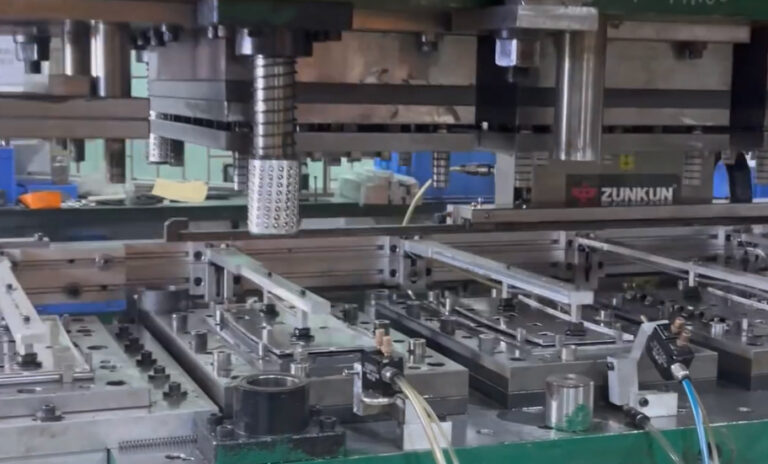
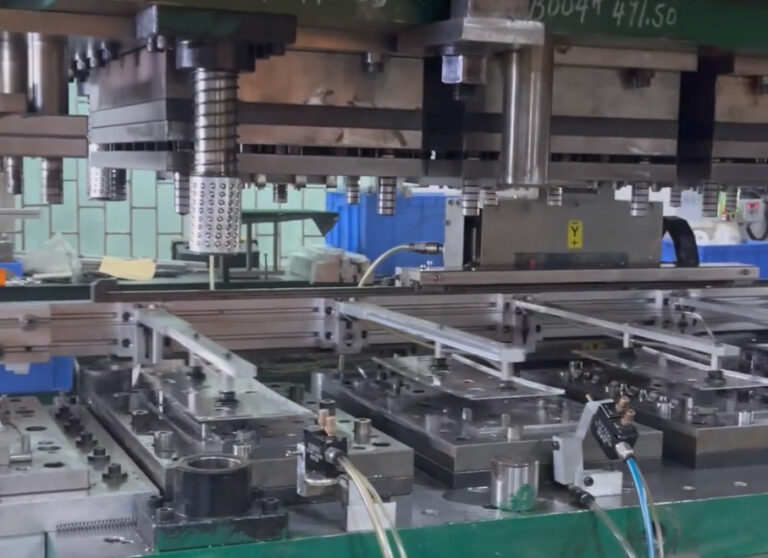
● Features:
– Used on multi-station punch presses
– Each station is a complete sub-mold that completes a specific process. Each sub-mold has a certain connection and is independently adjustable, and the adjustment is generally not limited by the front and rear sub-molds
– The parts are transferred by the robot
● Advantages:
– High Production Efficiency: It can realize the automatic production of complex products like continuous molds
– Convenient Adjustment: Each station can be adjusted independently, such as adjusting the drawing height
– Good Mold Versatility: Since each station is responsible for the required process, when producing different products with similar structures, only a few key parts need to be replaced, which greatly reduces the design workload, mold costs and processing lead time
– High Material Utilization: It eliminates the incision and tearing process required to separate the sheet from the carrier before drawing. For products with smaller sheets, it can save considerable materials
● Disadvantages:
– Strong Equipment Dependence: It must be used with a multi-station punch press, but there are relatively few multi-station punch presses to choose from
– Limited Product Applicability: Generally only deep-drawn products can be made, because it is difficult for the robot to clamp and stabilize products that are not deep-drawn into a cylindrical box shape. It is difficult to apply to some products with special shapes or difficult to be clamped by the robot
– Limited Production Speed: The maximum production speed is generally 70 to 80rpm, which is slower than that of the continuous mold
– Limited Mold Accuracy: Due to the size limitation of the sub-molds, the multi-station transfer mold cannot use the guide pins and guide sleeves with sand racks, and is limited by the slider guidance accuracy of the punch press. The mold guidance accuracy is affected, and it is difficult to make products with high precision
6. Metal Stamping Processes
The stamping process is broadly categorized into two main types: separation and forming processes.
6.1 Separation Process
The separation process is to create the workpiece with the required shape and size by cutting or dividing the sheet metal, it includes shearing and trimming.
6.1.1 Shearing
Separate the metal sheets to make the desired shape or inner hole. It includes:
I. Blanking

● The punched part is the finished product (such as a round gasket)
II. Punching
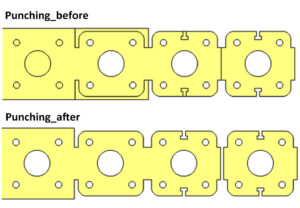
● The punched part is the waste (such as a screw hole)
III. CuttingOpen
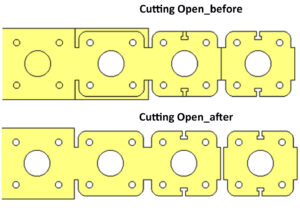
● A stamping process that partially but not completely separates the material along the open contour
IV. Edge Trimming
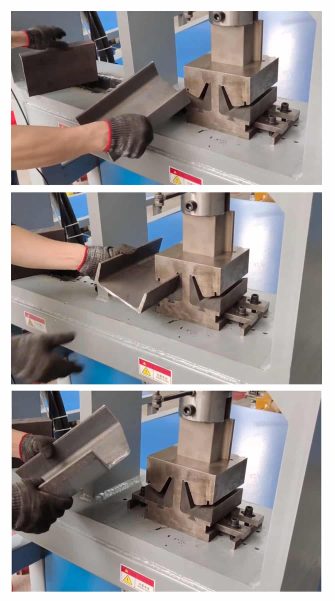
● Cut off the excess edge of the stretched part
V. Cutting Off
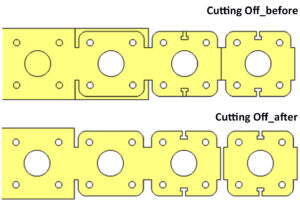
● The material is separated along the open contour
● The separated material becomes the workpiece
6.1.2 Repairing
● Repair the surface or internal defects such as burrs, cracks, deformation, etc. to ensure the dimensional accuracy and shape integrity of stamping parts
● The repair process usually includes cleaning, grinding, welding, and correction etc
6.2 Forming Process
6.2.1 Bending
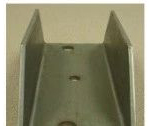
● Bend the sheet metal into a certain angle or shape
6.2.2 Rolling

● Roll the ends of the sheet into a round shape
6.2.3 Holes with Vertical Edge
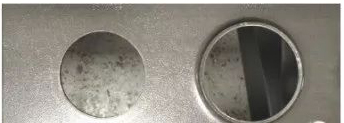
● Use a punching die to create vertical edges on the punched part
6.2.4 Flanging
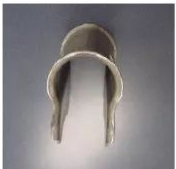
● Flange the outer edge of the stamped part to form a vertical edge in the shape of an arc or curve
6.2.5 Widening
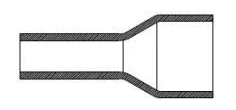
● Widen the mouth of a hollow part, commonly used for pipes
6.2.6 Narrowing

● Narrow the mouth of a hollow part
6.2.7 Deep Drawing
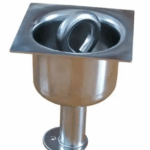
● Pull the flat plate into a hollow three-dimensional part (such as a tank body or shell)
6.2.8 Ribs
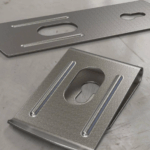
● Punch out ribs on stamped parts
6.2.9 Embossing

● Make localized protrusions on flat sheet metals
6.2.10 Bulging
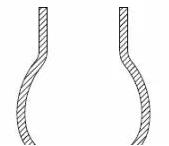
● Make the stamped part protrude locally and form a convex belly shape
7. Post-Treatments
7.1 Deburring
7.1.1 Mechanical Deburring
● Vibration Grinding: Suitable for small and complex parts, using ceramic abrasives to remove burrs
● BarrelPolishing: Batch processing of simple shape parts, steel balls or walnut shell abrasives can be added
● Sand/Grinding Wheel: Manual or automatic processing of large edges (such as automotive sheet metal parts)
7.1.2 Thermal Deburring
● Use intense heat generated from a controlled combustion of a fuel-oxygen mixture to remove burrs and flash from parts
● Suitable for precision parts (such as hydraulic valve bodies)
● Can handle hard-to-reach areas such as inner holes and cross holes
7.1.3 Chemical Deburring
● Remove burrsthrough chemical reaction between acidic or alkaline solution and metal burrs
● The solution should be selected according to the material of the workpiece (iron, copper, aluminum), and the burr thickness should usually be less than 0.2mm
7.1.4 Freezing Deburring
● The burrs are embrittled by rapid freezing with liquid nitrogen, and then removed by high-speed freezing particle impact
● It can handle 0.2mm hidden burrs without damaging the parts
● The qualified rate of treatment is over 98%
7.2 Cleaning
7.2.1 Wiping
● Use a cloth dipped in a cleaning agent to wipe the surface of the part to degrease
● Suitable for cleaning parts with large size, low volume and complex shapes
● The wiping can be used as an effective supplementary way when other methods are difficult to clean
7.2.2 Brushing
● Brushing is also a simple and effective cleaning method
● It can clean loose dirt on the surface
● Be careful not to use too much force to avoid scratching the surface of the metal workpiece
● It is suitable for small-scale production
7.2.3 Pickling
● Use the oxidizing properties of strong acids to remove grease and dirt from the surface
● It can remove the oxide scale, organic matter, alkaline film and corrosion spots on the metal surface, but it has an erosive effect on the surface
● Suitable for corrosion-resistant materials such as stainless steel
● It can also improve the metal’s corrosion resistance
7.2.4 Alkali
● Mainly clean the metal surface through the chemical action of alkali
● Commonly used to remove ferrous metals such as steel, nickel, copper, and non-ferrous metals that are insoluble in alkali
7.2.5 Organic Solvent
● Use the dissolving ability of organic solvents to remove dirt
● The cleaning time is short and it does not corrode metals
7.2.6 Ultrasonic Cleaning
● Use ultrasonic waves to produce cavitation effect in liquid to clean
● High efficiency: Can thoroughly remove hard-to-reach dirt, especially for parts with complex shapes or hidden crevices
● Environmental protection and energy saving: Usually only a small amount of cleaning liquid is needed to clean, reducing environmental pollution and waste of resources
● Non-contact cleaning: Will not damage the surface of parts, especially suitable for sensitive or fragile parts
7.2.7 Emulsion
● Mix immiscible phases (such as hydrocarbon solvents and water) to form an emulsion to remove oil stains from metal products
● Suitable for rapid oil removal and can offer temporary rust protection, especially for workpieces that require a slight film protection on the surface
7.2.8 Electrolysis
● Remove dirt through the gas or bubbles generated during the electrolysis process
● Environmentally friendly: it is non-toxic, non-pungent
● Wide applications: Suitable for parts with various shapes, especially the complex structures
● Easy operation: The equipment is simple to operate and easy to maintain, suitable for large-scale industrial applications
7.3 Heat Treatment
7.3.1 Purposes
I. Improve Material Properties
● The internal organization and properties of metal materials will change during the cold stamping process
● The material internal structure can be adjusted to improve its mechanical properties, such as improving hardness, strength and wear resistance
II. Internal Stress Relief
● Metal materials will be subjected to strong plastic deformation during the cold stamping process, resulting in large internal stresses inside
● If these internal stresses are not eliminated in time, they may cause deformation, cracking and other problems in the use of parts
● Heat treatment can effectively eliminate these internal stresses and increase the service life of parts through the process of heating and slow cooling
III. Improve Parts Dimensional Stability
● Due to the material’s elastic deformation, the dimensions may be unstable
● The material internal structure can be adjusted more uniform and stable, thereby improving the dimensional accuracy and stability of the parts
7.3.2 Annealing
● Full Annealing
– Heat to a certain temperature, keep part warm for some time and then slowly cool it down
– It is mainly to reduce hardness, improve plasticity, and facilitate cutting
● Spheroidizing Annealing
– Used to eliminate organizational defects and improve processing performance
● Stress Relief Annealing
– Relieve internal stress and prevent parts from deformation and cracking
7.3.3 Normalizing
● Heat the steel to 40-60℃above the critical temperature, keep it warm and then air cool it
● It is mainly used to improve the organizational structure and cut performance
7.3.4 Quenching
● Heat the steel to the quenching temperature, keep it warm and then quickly cool it (water, oil or air) to increase hardness and wear resistance
● Tempering is often performed after quenching to reduce the metal’s brittleness and increase toughness
7.3.5 Tempering
● Reheat the steel to a temperature below its critical transformation temperature, holding it at that temperature, and then cooling it down
● It is mainly used to adjust the hardness, improve plasticity and toughness
● Tempering is categorized into low, medium and high temperature tempering
7.3.6 Quenching and Tempering
● High temperature tempering after quenching
● Mainly used for structural parts to increase toughness and strength
7.3.7 Chemical Heat Treatment
● Infiltrate chemical elements (Include carburizing, nitriding, etc) into the surface of steel parts
● Change the surface chemical composition and properties, and improve wear resistance, corrosion resistance and fatigue strength
7.4 Surface Treatment
7.4.1 Surface Finishes
| Table 5 – Surface Finishes | |||
| Finishes | Features | Materials | Applications |
| Electroplating | ● Anode: plated metal or other insoluble materials ● Cathode: workpiece to be plated ● Coating: zinc, copper, nickel, chrome etc ● Enhance the corrosion resistance and increase hardness | Steel: Copper-based materials: Aluminum alloy materials: | Zinc plating: Copper plating: Nickel plating: |
| Physical Vapor Deposition (PVD) | ● In a vacuum environment, the material is deposited on the the workpiece surface to be plated by physical means to form a thin film ● The coating has high hardness, wear resistance and low friction properties | ● PVD coating can be directly plated on the surface of stainless steel and hard alloy ● For die castings such as zinc alloy, copper, and iron, they must first be treated with chemical electroplating chromium and then PVD coating to ensure a good coating effect | Consumer electronics: Automotive: Aerospace: Mechanical manufacturing: |
| Anodizing | ● Impressed current forms an oxide film on the aluminum product (anode) | Suitable for a variety of metal substrates, including: ● Aluminum ● Aluminum alloy ● Magnesium alloy, etc | Corrosion protection: Decorative effect: Insulation improvement: Increased hardness Hard anodizing: |
| Phosphating | ● Remove oil and rust from the metal surface, soak them in an acidic solution containing phosphates to form a phosphate film on the metal surface ● Provides protection for the base metal and prevents metal corrosion to a certain extent ● Used as a primer before painting to improve the adhesion and corrosion resistance of the paint film ● Reduce friction and lubrication in metal cold processing | Phosphating can be applied to: ● Steel ● Aluminum and its alloys ● Zinc and its alloys ● Cold-rolled carbon steel sheet | Auto parts: Mechanical: Aerospace: Construction: |
| Blackening | ● Also known as bluing or black oxide coating ● Rapidly oxidize the metal surface to form a dense oxide film protective layer ● It can improve the rust resistance | Carbon steel: Cast iron: Alloy steel: | Mechanical: Construction: Household: Industrial: Medical: |
| Passivation | ● Use a passivating or film-forming agent to treat the metal surface to form a stable and dense passivation film ● The passivation does not add thickness or change workpiece color, which imporves the part precision | Stainless steel: Aluminum: Titanium: Nickel and its alloys Molybdenum, Cobalt, Tantalum, Niobium, Tungsten Ferroalloys | Stainless steel: Aluminum: Titanium: Nickel and its alloys: Molybdenum, Cobalt, Tantalum, Niobium, Tungsten: Ferroalloys: |
7.4.2 Coatings
Features:
● Apply a uniform, corrosion-resistant coating on the metal surface
● The electrophoretic coating is full, uniform, flat and smooth
● Its hardness, adhesion, corrosion resistance, impact and penetration performance are significantly better than other coatings
Material:
● Applicable to stainless steel, aluminum alloy, aluminum, titanium, zinc, zirconium, magnesium, niobium and their alloys
Applications:
● Automobile: Automobile bodies, wheels, and engine parts
● Electrophoretic coating is used as a primer, usually placed between the phosphating layer and the midcoat, providing important anti-corrosion protection
● Home Appliance: Metal parts of refrigerators and washing machines
● Building Hardware: Metal products such as doors, windows, and railings
II. Painting
Features:
● Use pressure or electrostatic force to attach paint or powder to the workpiece surface, so that the workpiece has anti-corrosion and decorative effects
Material:
● Stainless steel, carbon steel, aluminum alloy, zinc alloy, copper alloy, titanium alloy etc
Applications:
● Aerospace: Blades of aircraft engines
● Automobile: Engine cylinders, pistons and other parts
● Construction: Doors, windows, railings, handrails
● Machinery: Housings and parts of mechanical equipment
III. Power Coating
Features:
● Generally refers to paint that needs to be heated before it dries
● There are two types: powder paint and liquid paint, the difference is that:
– The former is solid powder, the temperature is about 200 degrees, the powder can be recycled and reused with less waste and strong adhesion
– The latter is liquid, the temperature is about 150 degrees, the paint cannot be recycled, and the adhesion is slightly worse
Material:
● Cold rolled steel, galvanized steel, magnesium alloy, aluminum alloy, zinc alloy etc
Applications:
● Household: Dining tables and chairs, cabinet door panels, etc
● Electronics: Shells of mobile phones, computers, and televisions
● Automotive: car bodies and interior parts
7.5 Assembly
Assemble parts according to customers’ requirements, such as:
● Self-tapping screws: quick assembly of electrical housing
● Riveting: aluminum-steel hybrid connection of automobile body
8. Factors to Consider When Stamping Metal
8.1 Materials
8.1.1 Material Properties
● The material strength, hardness, plasticity, toughness and other properties have a great influence on the quality and production process of stamping parts, for example:
– Materials with high strength and hardness require greater pressure during stamping and are prone to cracking
● Materials with good plasticity and toughness are more conducive to forming and can reduce defects such as wrinkling and cracking
8.1.2 Material Thickness
● Material thickness determines the strength and rigidity of stamping parts, and also affects the selection of stamping processes and mold design
● Thicker materials require greater stamping pressure and stronger molds, while thinner materials are more prone to deformation and cracking
8.1.3 Material Surface Quality
● The roughness, flatness, scratches and rust will affect the surface quality and precision of stamping parts
● Materials with poor surface quality may cause the stamping parts urface to be rough and defective, and even affect the mold lifetime
8.2 Design
8.2.1 Part Structure
● The part shape should be as simple and symmetrical as possible, avoiding complex curves and sharp angles to reduce stress concentration and deformation during stamping
● The distance between holes, between hole and edge should not be too small
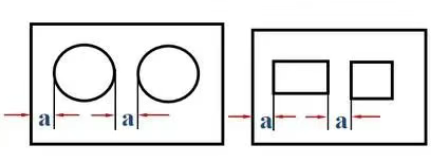
– Hard steel: a=(1.3~1.5)*T
– Brass, soft steel: a=(0.9~1.0)*T
– Copper, aluminum, zinc: a=(0.75~0.8)*T
a: distance between two holes, distance between hole and edge
t: material thickness
● When bending, cracks and breaks will occur when the bending radius exceeds the material’s ultimate strength, avoid small bending radius
● The radius should not be larger than 1.5 times the material thickness. If the radius is too large, the rebound will be large after bending
● Try not to design the bending line at the place where the width suddenly changes to avoid tearing
● If the bending line must be at the place where the width suddenly changes, it can pre-punch the process hole or groove at that place
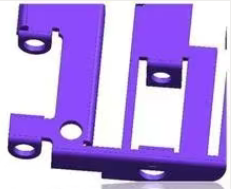
● For bent parts with holes, if the holes are located near the bending, the holes will be deformed. It can make these holes distributed outside to avoid deformation
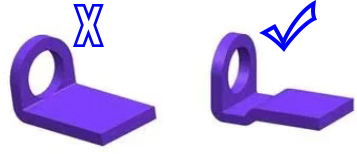
● When designing a bent part, consider whether there is enough space for the material to be unfolded (in the direction) before bending (the distance between the two pieces > t)
● Thin plates can add ribs to increase stiffness and strength
8.2.2 Dimension Tolerance
● Determine the reasonable dimensional accuracy and tolerance range
● Tight tolerances will increase production costs and difficulty
● While loose tolerances may cause the part to fail to meet the use requirements
8.2.3 Surface Roughness
● Determine the appropriate surface roughness according to the use environment and functional requirements, for example:
– For surfaces that require wear resistance and sealing, a lower surface roughness should be selected
– For some internal structures or non-critical surfaces, the surface roughness can be appropriately relaxed
8.3 Process
8.3.1 Stamping Process Selection
● Select the appropriate stamping process, such as blanking, bending, stretching, flanging, etc
● Different stamping processes have different effects on mold design, equipment and production efficiency
8.3.2 Mold Design
● The mold is the key equipment for stamping production
● The mold design should consider mold structure, material, precision, strength, and lifetime
8.3.3 Stamping Equipment
● The equipment performance and accuracy should match the stamping process and mold to ensure the part quality and production efficiency
8.4 Production
8.4.1 Production Batch
● In large-scale production, a stamping production line with a high degree of automation can be used to improve production efficiency and product quality
● In small-scale production, manual or semi-automatic stamping equipment can be used to reduce equipment investment costs
8.4.2 Cycle Time
● The cycle time can be controlled by adjusting the stamping equipment speed, the mold replacement time, and part assembly time etc
8.4.3 Quality Control
● Inspect and control the quality of the raw materials, molds, stamping processes and finished products
9. How to Reduce the Metal Stamping Cost?
Refer to the article below for details:
5 Ways to Reduce Metal Stamping Part Costs
10. Advantages and Disadvantages of Metal Stamping
10.1 Advantages
● High Efficiency: Suitable for mass production, regular presses can reach dozens of times per minute, high-speed presses can reach hundreds or even thousands of times per minute
● Stable Part Quality: The mold ensures the part’s size and shape accuracy, and generally does not damage the surface quality. The mold lifetime is long, so the stamping quality is stable
● High Material Utilization Rate: Less or no raw material waste during the stamping, which can save material costs
● High-Strength Parts: Directly use the mechanical properties of metal sheets, which can produce high-rigidity and high-strength parts without subsequent processing
● Complicated Shape Parts: Stamping can make parts with large sizes and complex shapes, such as automobile longitudinal beams, covers, workpieces with reinforcing ribs, undulations or flanging to improve their rigidity
● Good Surface Quality: The surface quality is good, which facilitates subsequent surface treatment, such as electroplating and painting)
● High Degree of Automation: Can be used with punch press to automatically feed materials to achieve fully automated production
10.2 Disadvantages
● High Mold Costs: The mold development cost is high (especially the precision progressive mold), which is not suitable for low volume orders
● Limited by Material Shape and Thickness: Usually only suitable for thin plates (typically 0.1-6mm), thick plates or three-dimensional complex structures are difficult to be made
● Part Structure Limitations: The part structure is limited by the mold. And it is difficult to create complex inner or three-dimensional structures
● Material Restrictions: Only workable to metal sheets (such as steel, aluminum, copper, etc.), not suitable for plastics or brittle materials such as cast iron, bronze, etc.
10.3 Compare to Other Processes
| Table 6 – Metal Stamping VS Other Processes | ||||
| Items | Metal Stamping | Injection Molding | Die Casting | Machining |
| Material | Metal sheets (steel, stainless steel, aluminum, etc.) | Thermoplastics (ABS, PP, etc.) | Liquid metals such as aluminum alloys and zinc alloys | Solid metal or plastic blanks |
| Structure | Thin-walled metal parts, flat parts | Hollow, complex plastic parts | Complex metal shells, structural parts | Any structure, flexible |
| Production Efficiency | Very high | High | Medium | Low |
| Mold Cost | High | Medium | High | No mold or low |
| Unit Cost | Very low (large batch) | Low | Medium | High |
| Surface Quality | Good | Good | General (need post-processing) | Excellent (can reach mirror finish) |
| Tolerance | typically ±0.1mm to ±0.2mm | typically ±0.1mm to ±0.5mm | typically ±0.1mm to ±0.2mm | typically ±0.001mm to 0.1mm |
| Batch | Medium-large batches | Medium-large batches | Medium-large batches | Small batches, customization |
| Applications | Hardware, terminals, electrical brackets | Mobile phone cases, toys, plastic gears | Automobile housings, lamp housings | Precision shafts, mold parts |
11. Common Metal Stamping Defects and Measures
| Defects | Pictures | Descriptions | Causes | Measures |
|---|---|---|---|---|
| Burrs | 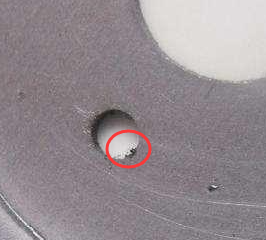
| There are sharp protrusions on the edge of the part | ● The mold gap is too large ● The mold edge is worn ● Wrong punching speed | ● Grind or replace the mold ● Adjust the gap, and regularly maintain the edge ● Add deburring process |
| Wrinkling | 
| Wrinkles and undulations on the surface of the sheet | ● The material flows unevenly in the mold ● The partial pressure is too large ● the material thickness is uneven | ● Optimize mold design ● Increase the material thickness appropriately ● Optimize process parameters |
| Pull Marks/Scratches | 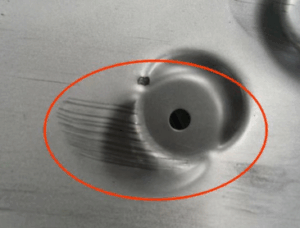
| There are obvious scratches and line marks on the surface | ● Sharp dents on the surface of the convex and concave die ● The gap between the convex and concave dies is too small or uneven ● The radius of the concave die is rough ● There are foreign materials on the working surface of the die or the material surface, damaging the working surface ● When the convex and concave dies’ hardness is low, metal scraps attached to the surface will also cause pull marks on the working surface after deep drawing | ● Grind or polish the scratched surface ● Increase the gap between the convex and concave die ● Repair and polish the radius of the concave die ● Keep the surface of the convex and concave die clean ● Increase the surface hardness of the male and female dies |
| Dimensional Deviation | 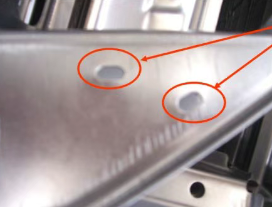
| Sizes, hole position are not within the tolerances: ● Hole deformation, hole not punched through, hole offset | ● Mold wear or unreasonable gap ● Springback during blanking ● Uneven material thickness ● Improper adjustment for multi-process parts ● Poor positioning during operation ● Incorrect blanking sequence ● Insufficient mold stroke ● Improper positioning | ● Regularly check and repair mold gap ● Take measures to reduce springback ● Control the thickness tolerance of incoming materials ● Reasonably arrange blanking sequence ● Improve positioning accuracy ● Adjust the slider to the appropriate height during debugging ● Strictly follow the working procedures during production |
| Cracks | 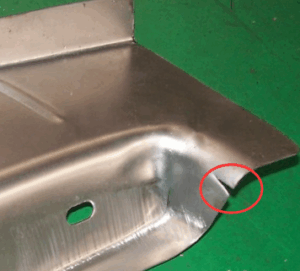
| Parts break at corners and stretching points | ● Poor material ductility ● High tensile force ● Too small fillet | ● Use materials with good plasticity ● Increase transition fillet ● Optimize mold design |
| Material Rebound | 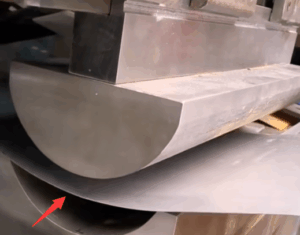
| The bending part rebounds, the angle deviation is large | ● The material elastic modulus is high ● The pressing strength is insufficient | ● Compensate for the angle design ● Increase the pressing material ● Select low rebound materials |
| Partial Thinning | 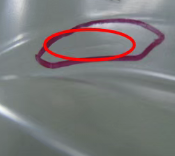
| The sheet becomes thinner during the stretching process | ● Excessive stretching (exceeding the material limit deformation rate) ● The mold radius does not match the material thickness | ● Control the stretching ratio ● Increase the mold radius or stretch in multiple steps |
12. Custom Metal Stamping Services
Custom Made to Your Specification
At Xiamen Eternal Precision, we have a dedicated engineering team to offer extensive custom capabilities and engineering support from design through production. Manufacturing capabilities include:
● CNC machining
● Die casting
● Injection molding
● Metal stamping
● Wire forming
Custom Made Manufacturer
We turn your ideas or concept into reality.
Our experienced engineers are ready to provide personalized application support and expertise to determine the best solution for your needs.
Our support goes further than just technical assistance, we will make sure our parts are working for you and your application from start to finish.
Contact us to get a quick quote and evaluation.
13. Conclusion
Metal stamping is an efficient, low-cost metal forming process suitable for mass production, which can quickly produce thin plate parts with consistent size and stable structure.
Although it is highly dependent on molds and has limited structural design, it is still an irreplaceable key processing method in the automotive, home appliance, electronics and other industries.



